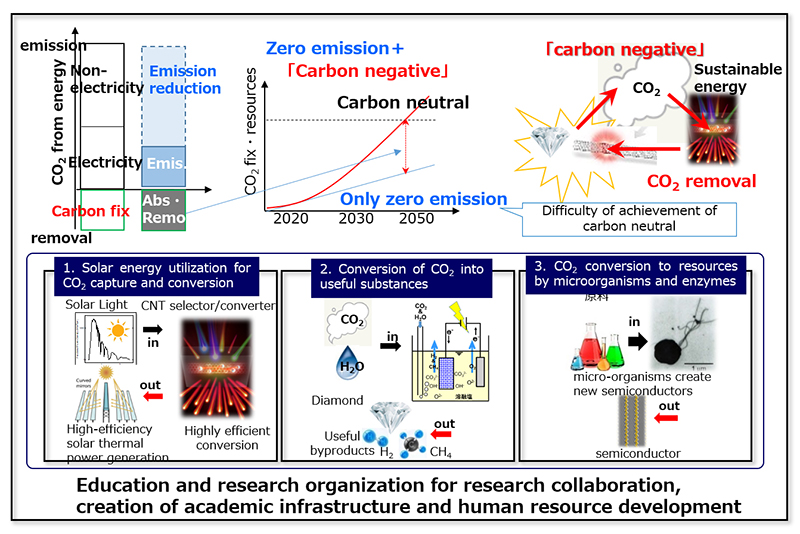Overview
Overview of Integrated Research Center for Carbon Negative Science
On our planet, carbon dioxide is used as a carbon currency through the carbon cycle system of living organisms. Until now, the balance between emissions and absorption of this currency, carbon dioxide, has been maintained. But rapid human activity since the Industrial Revolution has led to an imbalance between emissions and absorption of carbon dioxide, and carbon dioxide emission has become excessive. To return to a balanced state, i.e., carbon neutrality, it will be difficult to achieve with “Zero Emission” technology alone, as they are usually referred to. It is necessary to create a new energy system by introducing more aggressive carbon dioxide fixation processes.
The Integrated Research Center for Carbon Negative Science (ICaNS) was established to develop such new carbon dioxide fixation technologies in 2022. In collaboration with the Graduate School of Engineering and the Graduate School of Energy Science at Kyoto University, the Center will also work on human resource development for “carbon negative energy”, which is relatively new at this point in time.
The Activity of the Integrated Research Center for Carbon Negative
Science
The ICaNS was established in 2022 as a platform to promote cross-disciplinary and dynamic research on carbon-negative energy within Kyoto University, starting from the collaboration between the Institute of Advanced Energy and the two graduate schools of Energy Science and Engineering. The center has established three projects to promote research with the benchmark of a 46% reduction in greenhouse gas emissions by 2030.
The projects include the development of “wavelength-selective and quantum conversion carbon nanotubes” from CO2, “atmospheric pressure and low-energy diamond electrolytic synthesis” from CO2 and water, and “graphene nanoribbon semiconductors” and “high value-added chemical products” made from CO2 using extreme microbes. In order to promote and develop such advanced interdisciplinary research and to link it to social implementation, it is necessary to “develop human resources to support academic and social implementation of carbon negativity,” and faculty members from three departments and seven majors within the university will gather at the center to conduct research and education using state-of-the-art research facilities while integrating diverse academic foundations. The center will also provide research and education using state-of-the-art research facilities. Using this as a foothold, further collaboration and new knowledge will be introduced in the future by all-Kyoto University to advance new “carbon-negative” academics. Furthermore, we will promote external and international collaboration to create carbon-negative energy technologies that contribute to social innovation and contribute to the development of human resources with an international carbon-negative perspective, with a view toward the realization of a carbon-neutral society in 2050 and beyond. The formation of such a research and education center through flexible collaboration between the university’s research institutes and multiple graduate schools will directly contribute to strengthening the functions of the university and the infrastructure for joint usage and joint research centers. The center’s research on the use of CO2 as a useful resource will lead the way toward a new paradigm, “carbon negativity,” in which the university takes the initiative. In addition, as a social ripple effect, it is expected to simultaneously achieve carbon negativity and regional development through projects such as carbonization and functionalization projects combining solar power generation on abandoned farmland and woody biomass from reforested abandoned land. These, together with the formation of a new academic community, will set a new path for solving global energy and environmental issues and realize a carbon-neutral society in 2050.

